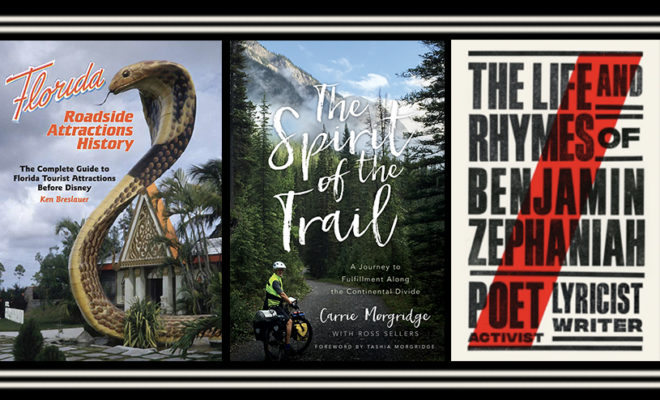
Literature
Literary Scene
Three nonfiction books about travel and life
By Ryan G. Van Cleave
Florida Roadside Attractions History:
The Complete Guide to Florida Tourist Attractions Before Disney
by Ken Breslauer
I love Florida and I love weird stuff even more, so seeing Ken Breslauer’s new 208-page full-color book on the history of pre-1971 Florida roadside attractions? I had to check it out. If you’re into kitsch, pop culture oddities, or general Florida strangeness, this book is for you.
Breslauer wrote this book “to recognize the historical significance of Florida’s commercial roadside tourist attractions that was virtually ignored by Florida historians until very recently. Their contribution to Florida’s biggest industry, tourism, has been enormous.”
Sure, we all know about the bird shows and alligator wrestling. But what about simulated earthquakes? Reptile institutes? Bull frog farms? Gardens of light?
There’s Anirama (Miami, 1952-1959), which featured toys and animated mechanical devices used in parades, movies, TV shows, and fairs. There’s Fairyland (Tampa 1953-1962), a storybook park for children that was located adjacent to what eventually became Lowry Park Zoo. And there’s Tarzan Park (Vero Beach, 1939-1942), where for 25 cents, tourists could see prehistoric human and animal remains, including the infamous “Vero Man,” which was later found to be a hoax.
This book is interesting through and through. What’s truly impressive is how many photos are not the stock postcard images of these places, but rather new ones found in historical or personal archives.
For the right reader, there’s an afternoon of oohs, aahs, fun, and nostalgia in these pages.
Rating: 4.25 out of 5
www.FloridaAttractionsHistory.com
Sidenote: Breslauer is the “leading collector of Florida tourist attraction memorabilia.” I truly hope there’s some governing body out there somewhere that gives out this official designation!
The Spirit of the Trail: A Journey of Fulfillment Along the Continental Divide
by Carrie Morgridge
Florida author Carrie Morgridge’s second book, The Spirit of the Trail, follows the life-altering 2,800-mile bicycling trip she took with her husband in 2016. For 46 days, they averaged 60 miles of travel along the Great Divide Mountain Bike Route that goes from the Canadian Rockies (Banff, Alberta) to the Mexican border at Antelope Wells, New Mexico. Along the way, they crossed the Continental Divide three dozen times and did more than 200,000 feet of vertical climbing.
The most important things she took away from the experience? “That I can’t wait to do it again,” she says. “That life moves on with or without you, so take the time for yourself and get out and just do it. Don’t be afraid to lose time at work—it will be there for you when you get back. There’s a mind shift on the trail that’s hard to describe, yet I think it’s what we all long for. Just living in the moment, no big cares in the world, being slightly to hugely uncomfortable . . . biking the GDMBR was one of the greatest accomplishments of my life.”
Part of the fun of this book is the deep sense of detail provided, from eating out of cans, sleeping on the ground, hearing a meadowlark, or stumbling across a field of wildflowers. For those interested in taking their own bicycling adventure, this book can serve as an informal guide that never gets so technical that the story gets lost.
If you liked Cheryl Strayed’s Wild, Bill Bryson’s A Walk in the Woods, or Robyn Davidson’s Tracks, this book might be just what you’re looking for. And perhaps best of all, 100% of the proceeds of this book go to the nonprofit Adventure Cycling Association, the premier bicycle-travel organization in North America.
Rating: 4 out of 5
www.morgridgefamilyfoundation.org/books/spirit-of-the-trail
The Life and Rhymes of Benjamin Zephaniah: The Autobiography
by Benjamin Zephaniah
I’m a sucker for poetry, so when I saw this autobiography, I had to read and review it. Zephaniah—a self-described “poet, writer, lyricist, musician and naughty boy”—has been offering up powerful rhymes and potent language since the 1980s, when his words were heard at demonstrations as often as they were in dance halls.
In the early 80s in London, he was part of the reggae, ska, and punk scene, mostly by badgering bands into letting him warm up the crowd with his performance poetry. Even then, his work was quite political, featuring poems with such titles as “Dis Policeman Keeps on Kicking Me to Death.” Considering the tumultuous life he led, Zephaniah ranks reaching age 30 without getting shot as one of his greatest achievements.
By the 1990s, Zephaniah had traveled to and performed on every continent in the world. And he’s been touring ever since. His many accomplishments include becoming a major star in Yugoslavia and taking Bob Marley’s place as the front person of the Wailers.
It’s a little unclear whether Zephaniah considers himself a poet, a reggae artist, or something else entirely. But this autobiography is an interesting read that reveals his powerful life story and ultimately seeks to celebrate the power of language and importance of pushing boundaries within the world of art.
Rating: 4 out of 5
www.BenjaminZephaniah.com



You must be logged in to post a comment Login